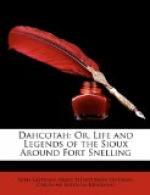Starvation forces the hunters to seek for the buffalo in the depth of winter. Their families must accompany them, for they have not the smallest portion of food to leave with them; and who will protect them from the Chippeways!
However inclement the season, their home must be for a time on the open prairie. As far as the eye can reach, it is a desert of snow. Not a stick of timber can be seen. A storm is coming on too; nothing is heard but the howling blast, which mocks the cries of famished children. The drifting of the snow makes it impossible to see what course they are to take; they have only to sit down and let the snow fall upon them. It is a relief when they are quite covered with it, for it shelters them from the keenness of the blast!
Alas! for the children; the cry of those who can speak is, Give me food! while the dying infant clings to its mother’s breast, seeking to draw, with its parting breath, the means of life.
But the storm is over; the piercing cold seizes upon the exhausted frames of the sufferers.
The children have hardly strength to stand; the father places one upon his back and goes forward; the mother wraps her dead child in her blanket, and lays it in the snow; another is clinging to her, she has no time to weep for the dead; nature calls upon her to make an effort for the living. She takes her child and follows the rest. It would be a comfort to her, could she hope to find her infant’s body when summer returns to bury it. She shudders, and remembers that the wolves of the prairie are starving too!
Food is found at last; the strength of the buffalo yields to the arrow of the Sioux. We will have food and not die, is the joyful cry of all, and when their fierce appetites are appeased, they carry with them on their return to their village, the skins of the animals with the remainder of the meat.
The sufferings of famine and fatigue, however, are followed by those of disease; the strength of many is laid low. They must watch, too, for their enemies are at hand.
CHAPTER III.
In the summer of 1844 a large party of half-breeds and Indians from Red river,—English subjects,—trespassed upon the hunting grounds of the Sioux. There were several hundred hunters, and many carts drawn by oxen for the purpose of carrying away the buffalo they had killed. One of this party had left his companions, and was riding alone at some distance from them. A Dahcotah knew that his nation would suffer from the destruction of their game—fresh in his memory, too, were the sufferings of the past winter. What wonder then that the arrow which was intended for the buffalo, should find its way to the heart of the trespasser!
This act enraged the half-breeds; they could not find the Sioux who committed it—but a few days after they fell in with a party of others, who were also hunting, and killed seven of them. The rest escaped, and carried the news of the death of their braves to their village. One of the killed was a relative of Sullen Face. The sad news spread rapidly through the village, and nothing was heard but lamentation. The women cut long gashes on their arms, and as the blood flowed from the wound they would cry, Where is my husband? my son? my brother?




